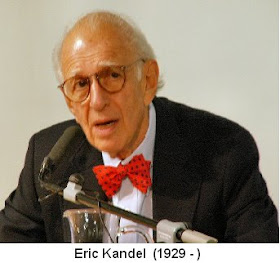
The Nobel Prize in Physiology or Medicine 2000.
"for their discoveries concerning signal transduction in the nervous system"
 Eric R. Kandel (1929 - ) won the Noble Prize in 2000 for his work on understanding the biochemistry of memory. He discovered that short term memory in the sea slug Aplysia depended on the phosphorylation and dephosphorylation of proteins and that the regulation of these covalent modifications was under the control cyclic AMP mediated signal transduction pathways.
Eric R. Kandel (1929 - ) won the Noble Prize in 2000 for his work on understanding the biochemistry of memory. He discovered that short term memory in the sea slug Aplysia depended on the phosphorylation and dephosphorylation of proteins and that the regulation of these covalent modifications was under the control cyclic AMP mediated signal transduction pathways. Kandel shared the prize with Arvid Carlsson and Paul Greengard.
Here's what the press release says about Kandel's work
THEME:
Nobel Laureates
Eric Kandel
Sea slug, a model system for learning
A phosphorylation of proteins has great importance also for the discoveries for which Eric Kandel is rewarded, that is for revealing molecular mechanisms, important for the formation of memories. Eric Kandel started to study learning and memory in mammals, but realized that the conditions were too complex to provide an understanding of basic memory processes. He therefore decided to investigate a simpler experimental model, the nervous system of a sea slug, Aplysia. It has comparatively few nerve cells (around 20.000), many of which are rather large. It has a simple protective reflex that protects the gills, which can be utilized to study basic learning mechanisms.Eric Kandel found that certain types of stimuli resulted in an amplification of the protective reflex of the sea slug. This strengthening of the reflex could remain for days and weeks and was thus a form of learning. He could then show that learning was due to an amplification of the synapse that connects the sensory nerve cells to the nerve cells that activate the muscle groups that give rise to the protective reflex.
Short and long term memory
Eric Kandel showed initially that weaker stimuli give rise to a form of short term memory, which lasts from minutes to hours. The mechanism for this "short term memory" is that particular ion channels are affected in such a manner that more calcium ions will enter the nerve terminal. This leads to an increased amount of transmitter release at the synapse, and thereby to an amplification of the reflex. This change is due to a phosphorylation of certain ion channel proteins, that is utilizing the molecular mechanism described by Paul Greengard.
A more powerful and long lasting stimulus will result in a form of long term memory that can remain for weeks. The stronger stimulus will give rise to increased levels of the messenger molecule cAMP and thereby protein kinase A. These signals will reach the cell nucleus and cause a change in a number of proteins in the synapse. The formation of certain proteins will increase, while others will decrease. The final result is that the shape of the synapse can increase and thereby create a long lasting increase of synaptic function. In contrast to short term memory, long term memory requires that new proteins are formed. If this synthesis of new proteins is prevented, the long term memory will be blocked but not the short term memory.
Synaptic plasticity, a precondition for memory
Eric Kandel thus demonstrated that short term memory, as well as long term memory in the sea slug is located at the synapse. During the 1990's he has also carried out studies in mice. He has been able to show that the same type of long term changes of synaptic function that can be seen during learning in the sea slug also applies to mammals.The fundamental mechanisms that Eric Kandel has revealed are also applicable to humans. Our memory can be said to be "located in the synapses" and changes in synaptic function are central, when different types of memories are formed. Even if the road towards an understanding of complex memory functions still is long, the results of Eric Kandel has provided a critical building stone. It is now possible to continue and for instance study how complex memory images are stored in our nervous system, and how it is possible to recreate the memory of earlier events. Since we now understand important aspects of the cellular and molecular mechanisms which make us remember, the possibilities to develop new types of medication to improve memory function in patients with different types of dementia may be increased.
Figure 4.
A sea slug, Aplysia, has a simple nervous system and a gill withdrawal reflex that Eric Kandel has utilized to study learning and memory.Figure 5.
A schematic description of how molecular changes in a synapse may produce "short term memory" and "long term memory" in the sea slug, Aplysia. The figure shows a synapse that is affecting another synapse. Short term memory can be produced when a weak stimulus (thin arrows in the left lower part of the figure) is causing a protein phosphorylation of ion channels, which leads to a release of an increased amount of transmitter. For a long term memory to be created, a stronger and more long-lasting stimulus is required (bold arrows in the figure). This causes an increased level of the messenger molecule cAMP, which causesa further activation of protein kinases. They will phosphorylate different proteins and affect the cell nucleus, which in turn will issue orders regarding the synthesis of new proteins. This may lead to changes in the form and function of the synapse. The efficacy of the synapse can then be increased and more transmitter released.
[Photo Credit: Eric Kandel: Wikipedia]


No comments:
Post a Comment